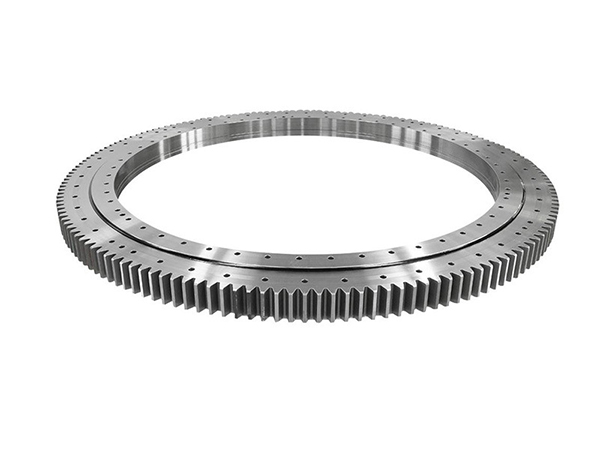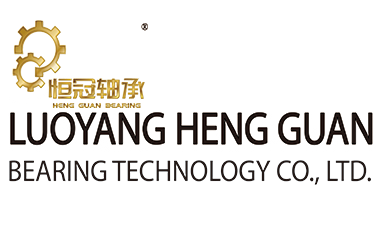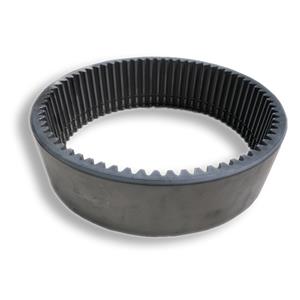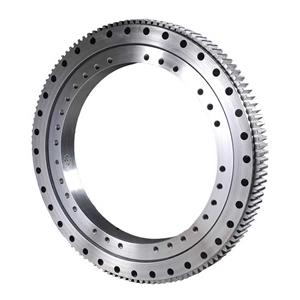Problems attention when installing slewing bearing
Problems attention when installing slewing bearing
Many users do not know enough about the installation of the slewing bearing, which often leads to the failure of the slewing bearing to work properly due to incorrect or incorrect installation, such as inflexible rotation and abnormal noise. Learning how to install slewing rings and slewing bearings, you can reduce problems and mistakes when installing slewing rings.

1. Before the slewing bearing is installed, the installation surface should be checked first. It is required that the support should have sufficient strength, the connecting surface should be machined, and the surface should be smooth and free of debris and burrs. For those that cannot be machined to achieve the required flatness, special plastics with high injection strength can be used as fillers to ensure the accuracy of the installation plane and to reduce vibration. The ring of the slewing bearing has a quenched soft belt area, which is marked S on the end face of the ring. When installing, the position of the soft belt should be placed in the non-load area or the non-regular load area (the plug hole is always located at the soft belt. ).
2. When installing the slewing bearing, radial positioning should be carried out first, the installation bolts should be cross-tightened, and the rotation of the bearing should be checked. To ensure smooth bearing drive, the gears should be checked for meshing before the mounting bolts are not tightened. There should be sufficient pre-tightening force when tightening the bolt, and the pre-tightening force should be 70% of the yield limit of the bolt material. Mounting bolts should be equipped with quenched and tempered flat washers, and spring washers are strictly prohibited. After the slewing bearing is installed and put into operation, after 100 hours of continuous operation, it should be fully checked whether the pre-tightening torque of the mounting bolts meets the requirements, and the above inspection should be repeated every 500 hours of continuous operation.
3. After the slewing bearing is installed, an appropriate amount of grease should be filled, and the slewing bearing should be filled at the same time to make the grease evenly distributed. After working for a period of time, the slewing bearing will inevitably lose a part of the grease, so the slewing bearing in normal operation should be replenished with grease every 50 to 100 hours. For slewing bearings that work in a high temperature environment or under dusty conditions, the period of adding lubricating grease should be appropriately shorter. When the machine is to be shut down for storage, it must also be filled with sufficient grease.
4. During transportation, the bearing should be placed horizontally on the vehicle, and there should be measures to prevent sliding and vibration, and auxiliary support should be added if necessary.
5. Bearings should be placed horizontally on a dry, ventilated and flat site, and should be isolated from chemicals and other corrosive items during storage. If multiple sets of bearings are required to be stacked together, three or more wooden blocks with the same height should be evenly placed between each set along the circumferential direction, and the upper and lower blocks should be placed in the same position. Bearings that still need to be stored beyond the rust-proof period should be cleaned and rust-proofed again.
6. For flat installation, the installation surface should be smooth and clean, and all excess substances such as paint residues, welding beads, burrs, etc. should be removed. When cleaning, be careful not to let the solvent penetrate into the inside of the slewing bearing, and do not use the solvent that damages the sealing material. Mounting surfaces should be dry and free of lubricants prior to assembly. Measures should be taken to protect workers and the environment. The roughness of the mounting surface of the mounting support is not greater than Ra=12.5, 6.3 μm, and the error of the flatness of the mounting surface must be detected by circumferential error and radial error. The circumferential flatness tolerance value has a corresponding standard value range with the diameter of the slewing bearing raceway.
7. The inner and outer raceways of the slewing bearing have a soft belt, which should be placed on both sides of the main load plane. That is, it is 90 degrees staggered from the main load area. There is a jam or "S" mark on the soft strap. In addition, check the fit of the slewing bearing and the mounting surface, usually with a feeler gauge. If the fit is not good, fill it with appropriate materials. After the slewing bearing is installed, it is forbidden to carry out welding operations on the support.
Installation of slewing bearing and problems that need attention
8. Solid bolts (1) Selection of mounting bolts: The specified mounting bolts and washers should be used. Also note: Do not use fully threaded bolts, do not use old bolts, nuts and washers, and prohibit the use of open washers such as elastic washers.
(2) Selection of bolt pre-tightening torque: The pre-tightening force of ordinary metric bolts is recommended to be 0.6-0.7 times the yield strength of the bolt. It is recommended that bolts larger than M27 use hydraulic tightening devices, and the pre-tightening force should not exceed 85% of the yield strength.
(3) Fastening bolts: The slewing bearing should be installed under no-load conditions. Note: Apply a little oil to the threads of the bolts to ensure the balance of friction resistance. Do not use glue on the bolt locking parts. Pre-tightening bolts: It should be pre-tightened in three steps, and the forces of the three steps are 30%, 80%, and 100% respectively.
9. Adjust the gear backlash. When installing a toothed slewing bearing, it is very important to adjust the gear backlash correctly. It can be adjusted with a feeler gauge at the highest point of the radial runout of the gear, or by pressing a lead wire or other suitable methods. If the backlash is not within the specified value, the pinion can be moved to change the center distance. After the adjustment, turn the slewing bearing at least one full turn to confirm that there are no other teeth jumping points, and check the backlash fake clearance after the slewing bearing is finally fixed. The highest point of gear runout is marked in the tooth groove with green paint.
10. Lubrication for the first time (1) Lubrication of the raceway: To ensure sufficient lubrication, the grease specified in the drawing or product instruction manual should be refilled before the initial use. Pay special attention to filling all the grease nipples with grease one by one, preferably while turning the slewing ring, until you see the grease squeeze out from the sealing ring. (2) Gear lubrication: When the gear is lubricated, the tooth surface should be clean. It is recommended to use a clean brush to apply grease to the gears.




